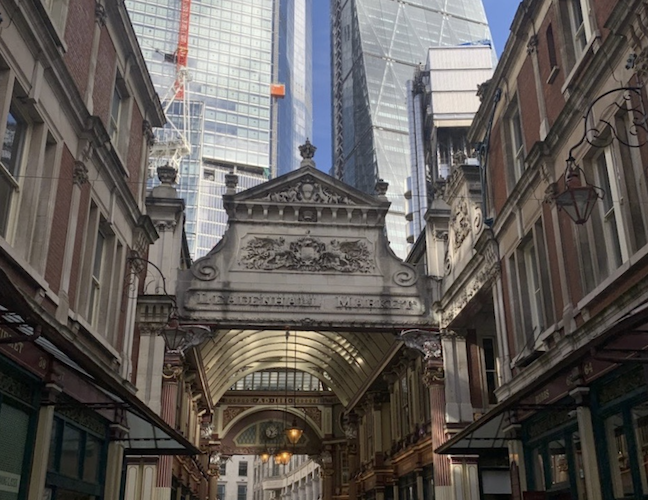If pictures could talk, the montage at the top of this article would have a tale to tell about 2,000 or more years of a historic part of London. The skyscrapers oiling the wheels of the City of London’s prosperity today stand behind the beautiful Leadenhall Market.
The market’s current form was designed in 1881 by Sir Horace Jones, who also gave the capital many other buildings, including the original Billingsgate Market and Tower Bridge. But a market has been on this site in one form or another since at least the 14th century, when it belonged to city dignitary Sir Hugh Neville.
In 1411 it was acquired by the City of London Corporation with the help of one Richard Whittington. According to Walter Thornbury’s 1878 Old and New London, Volume 2, reproduced at British History Online, when Don Pedro de Ronquillo, the Spanish ambassador, visited Leadenhall in the 1600s he told Charles II he believed there was more meat sold there than in all the kingdom of Spain in a whole year.
Occupying much of the land between Gracechurch Street and Leadenhall Street, the market used to be so large that in the 1720s a part of its land accommodated the headquarters of the East India Company, the biggest corporation in the world, as the map below shows.

And the age of today’s market buildings is as nothing compared with that of a piece of masonry found by archaeologists in the 1880s when Leadenhall was being reconstructed to Jones’ plan. Today, believe it or not, it is located in the basement of a barber’s shop where the market meets Gracechurch Street. The staff were amazingly friendly when I dropped by unexpectedly for a peek. It is down two flights of stairs and protected by a glass partition.

This unique artefact is a base of an arch that formed part of a basilica – a law court or assembly room – dating back to the year AD70. The basilica was the largest Roman building north of the Alps and the centre of Roman London, from where most roads to the rest of the country started. It is said to have been as tall as St Paul’s.
It was constructed on a five-acre site where the foundations of many rooms have been uncovered and recorded by archaeologists before being buried forever under new constructions. It stood along one side of a forum – a market place and a public space where citizens could meet and exchange ideas. Though much larger, the forum was not unlike Leadenhall today – a location where merchants, residents and visitors trade and party.
The basilica and forum lasted for over 200 years until they were destroyed, not by an alien force but by Rome itself as punishment for London supporting the rule of the “rogue emperor” Carausius.
In the medieval period that followed, Leadenhall was the most important market in London, especially for meat and poultry and also butter, cheese, wool and cutlery. As now, it would have been a hive of noisy activities, though much more smelly.
Today you still get a sense of the medieval as you emerge from narrow alleys into the magnificence of Jones’s marketplace. It is easy to see why it has found its way into films, including Harry Potter and the Philosopher’s Stone.
Leadenhall invites comparison with the even older Borough market on the other side of the Thames, which began at least as early as 1014. It has more sculpted charm than Borough, but is heavily dependent on commuting City workers. This ensures a lot of spending during the week, but Leadenhall almost goes to sleep at weekends.
That is a problem but also an opportunity. The City Corporation and the EC BID are seeking to attract more visitors from home and abroad. The infrastructure is already there and a huge reservoir of history remains to be fully exploited – from its Roman foundations upwards.
This is the sixth article in a series of 20 by Vic Keegan about locations of historical interest in the Eastern City part of the City of London, kindly supported by the EC BID, which serves that area. On London’s policy on “supported content” can be read here.


“ The basilica was the largest Roman building south of the Alps and the centre of Roman London”
Has London moved…?
Touché
Will be changed
It looks fine now. I used to go to collect meat rations for my mother during the Austerity post War. We lived in the City as it was rebuilt.